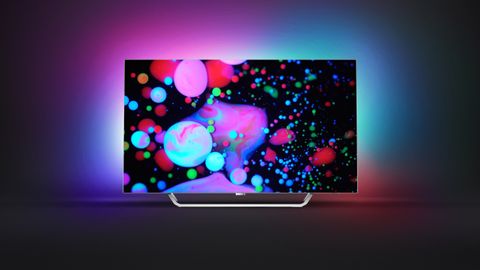TechRadar Verdict
The way Philips’ new P5 picture processing partners with OLED screen technology in the 55OLED873 is a revelation, leading to some of the most natural and immersive pictures around. Add Philips’ lovely Ambilight technology to the mix, and at £2,000 the 55OLED873 looks like a serious bargain.
Pros
- +
Ambilight works a treat
- +
Excellent all-round picture quality
- +
Good value
- +
Attractive design
Cons
- -
Android TV can annoy
- -
Slightly weak sound
- -
Complicated to use
- -
More dynamic images elsewhere
Why you can trust TechRadar
Philips opened its OLED TV account in impressive fashion a few months back with the 55POS901F. Given the success of that model, it was inevitable that Philips would look to follow it up with an OLED sequel. What we couldn’t have predicted, though, is just how good that sequel would turn out to be.
UPDATE: When we initially reviewed this TV, we reviewed it under its original name, the 55POS9002. However, at a recent event, the TV had its name changed to the 55OLED873. Confusing though the name change may be, the TV has otherwise remained unchanged. See our guide to the Philips TV lineup for a full outline of the range – or check out our Prime Day 2020 coverage to see what Philips TVs are discounted in Amazon's massive sale.
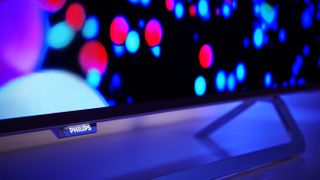
Design
Screen sizes available: 55- and 65-inches
Tuner: Freeview HD
Panel technology: OLED
4K: Yes
HDR: HDR10 + HLG
Smart TV: Yes, Android TV
Curved: No
Dimensions: 768.6 x 1230 x 227.5 mm (HxWxD inc stand)
3D: No
Inputs: 4 x HDMI, 2 x USB, Ethernet
First impressions of the 55OLED873 are mixed. During set up the TV feels lighter and more plasticky than any other OLED TV we’ve tested to date.
Once set up is complete, though, the set actually looks very attractive. A cunningly applied metallic finish hides the underlying plastickiness. The silvery colour scheme creates an airy, light feel. The minimalistic, centrally mounted desktop stand is both attractive and practical. And, best of all, it’s got Ambilight technology.
Ambilight, if you’re not familiar with its, uses an array of rear-mounted LEDs to cast out pools of light from a TV’s edges. This light that can be set to deliver either a single colour of your choosing, or continually adapt to the colour content of the images you’re watching.
It’s remarkable how accurately Ambilight is able to match both the tones and position of different colours within an image. The effect isn’t just pretty, though. Provided you use it on a relatively gentle setting, Ambilight can also help you feel more immersed in what you’re watching, and make long viewing sessions in dark rooms less fatiguing on your eyes.
Connections on the 55OLED873 are impressive. All four of its HDMIs, for instance, can handle 4K and HDR feeds. Its three USBs support multimedia playback as well as recording from the integrated Freeview HD tuner to an external HDD. Plus, of course, there are Wi-Fi and wired network options, supporting both DLNA streaming and access to Philips’ online services.
Design TL;DR: An initially plasticky appearance fades in importance once the TV is set up and the metallic finish combined with Ambilight takes over.
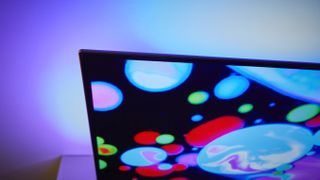
Smart TV: Android TV
The 55OLED873’s smart features are built around Google’s Android TV platform. This is not, for us, a cause for celebration. Android TV’s interface is overbearing with its cluttered, screen-filling home screen and lack of customisation options.
Another issue with Android TV is that while it features a huge number of apps, precious few of those apps are really useful in a TV (as opposed to smartphone or tablet) environment. At the same time, a number of apps you would ideally like to find are missing - including the ITV Player (which has confusingly seen an Android TV release that's exclusive to Nvidia's Shield TV), All4 and My5 terrestrial broadcasting catch up services. You do at least get Netflix and Amazon apps, though, and these are capable now of streaming in both 4K and HDR.
It’s worth adding on a more positive note, too, that the 55OLED873’s Android engine seems to run more stably and slickly than it does on Sony’s Android TVs.
One interesting aspect of the 55OLED873’s smart interface is the way the remote control carries a full QWERTY keyboard on its rear side. Anyone who’s had to use ‘soft’ on-screen keyboards to input any amount of text into a TV will instantly appreciate the usefulness of such a keyboard.
Smart TV TL;DR: A full QWERTY remote isn't enough to make up for Android TV's continuing annoyances.
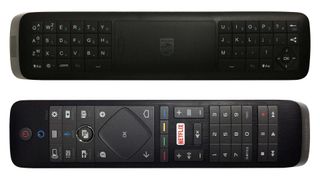
Picture technology
The single most important attraction of the 55OLED873 is its use of a 4K OLED panel. OLED technology enables every pixel to produce its own light independently of its neighbours, leading to contrast levels LCD TVs can typically only dream of. What’s more, unlike Philips’ 55POS901F OLED debutante, the 55OLED873 uses one of LG’s very latest OLED panel designs at its heart. This should enable it to produce significantly brighter and less noisy pictures than the 55POS901F.
The 55OLED873 also improves over the 55POS901F with its video processing, which is delivered by a new ‘P5’ engine. The P5 name comes from the way the processor addresses all five of the most important picture elements: contrast, colour, motion, sharpness and source recognition. Philips claims P5 is as much as 25% more powerful than any previous Philips picture engine, and also applies that power more efficiently thanks to the way it combines processing that used to be spread across three separate chips onto one single chip.
The 55OLED873 supports playback of high dynamic range (HDR) sources too, in the HDR10 and (broadcast-friendly) HLG formats. It does not, however, handle either of the two ‘dynamic’ HDR formats now out there: Dolby Vision and HDR10+.
Picture technology TL;DR: Panel improvements and a new picture processing engine promise a brighter screen and better picture processing.

Picture performance
The 55OLED873 is both a strong picture performer and unique enough in the way it goes about its picture business to stand as a genuine alternative to similarly priced OLED competitors.
The best way to sum up the 55OLED873’s picture charms is by saying that they’re all about naturalism. In other words, when set up to deliver their optimum all-round results, they sacrifice a touch of the outright drama and dynamism of rival LG’s OLED pictures to focus on better shadow detailing, reduced noise and more consistent light management.
Take black level reproduction, for instance. The Philips 55OLED873 doesn’t plumb quite such extreme black colour depths as LG’s sets, leaving a faint hint of greyness hanging over really dark scenes. However, it does a better job than LG’s TVs of reproducing every last hint of shadowy detailing in even the darkest corners, making images look more balanced and ‘complete’, if slightly less showily dramatic.
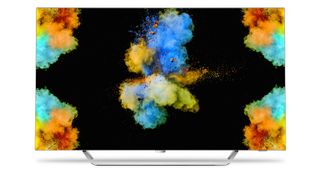
Also, while LG’s TVs can exhibit occasional localised, low-level noise in dark areas, Philips’ P5 processing means that the 55OLED873’s HDR images look rock solid and clean, without so much as a hint of noise (aside from anything that might be in a source).
The 55OLED873’s measured light output on a 10% white HDR window of 740 nits when using the brightest Movie picture preset is pretty much a match for LG’s latest OLEDs. Strangely, though, the 55OLED873’s pictures don’t look quite as dynamic with normal HDR video content (as opposed to test signals). While this joins with slightly deeper black levels in giving LG’s latest OLED pictures a bit more ‘oomph’, though, the Philips pictures look slightly more even and balanced.
What’s more, there seems to be a little more precision in the 55OLED873’s light management at the pixel level. As well as the extra shadow detail already pointed out, there seems a little less ‘clipping’ of subtle tonal shades in HDR image’s brightest areas, and a little more refinement in the delivery of colour blends and skin tones.

The 55OLED873 excels with its sharpness, too. It reproduces every minute detail from the best 4K Blu-rays or streams, yet interestingly it does this without making the sharpness look ‘forced’ in the way it sometimes can with Philips’ 4K TVs.
Upscaled HD images also look marginally softer but overall more immersive and convincing than they have tended to on previous Philips TVs. This could be down to either the sort of improvements and efficiencies delivered by the P5 processing, or it could be more evidence of what feels like a general shift in Philips’ picture quality thinking towards a less aggressive, more naturalistic approach.
The P5 engine appears to have had a revelatory impact on Philips motion handling, too. We’d expected to see exceptionally potent motion processing that completely removes all judder and blur but leaves images looking unnervingly fluid and affected by messy processing side effects. in fact, though, a new Movie motion setting does a superb job of gently massaging away judder and blur without creating unwanted artifacts or coming on too strong.
Finally, the 55OLED873 handily sidesteps another previous Philips TV shortcoming by suffering just 35ms or so of input lag (the time it takes to render image data) when using its Game preset. This is a solid to good result that shouldn’t seriously impact your fast-reaction video gaming skills.
Picture Performance TL;DR: The new P5 engine really gets the most out of the OLED panel. Blacks are detailed and noise-free, sharpness is decent, and motion is handled very well.
Sound quality
While the 55OLED873 improves on the picture quality of Philips’ debut OLED TV, it takes a step back sonically.
The thing is, the POS901F sported a built-in, forward-facing soundbar along its bottom edge while the 55OLED873 does not. This means the 55OLED873 can’t deliver as much direct impact, detail, clarity and attack as its predecessor.
Compared with similarly priced current TVs, though, it gives a pretty decent account of itself. Its so-called Triple Ring speaker system proves able to handle pretty extreme volumes without phutting or buzzing, and a rear-mounted woofer proves potent enough to underpin the sound with a passable amount of bass.
Sound TL;DR: Overall, the 55OLED873 sounds decent enough to make adding an external audio system more of an option than a necessity.
Other panels to ponder
The most direct competition for the 55OLED873 are LG’s OLED55B7 and OLED55C7 OLED TVs. The B7 can be bought now for a couple of hundred pounds less than the Philips set, offers the excellent WebOS smart system, and delivers more dramatic, contrast-rich pictures. It doesn’t have Ambilight, though, and its pictures are slightly noisier and slightly less subtle than those of the Philips.
Another great option is the Panasonic TX-55EZ952 OLED TV. This has just received a significant price cut, putting it in the same price zone as the Philips, and benefits from Panasonic’s excellent, ‘Hollywood-tuned’ processing. Again, though, there’s no Ambilight.
Verdict
The £2,000 TV market has started to get pretty congested this year, but the Philips 55OLED873 does enough to stand out from the crowd. Its Ambilight system is as fun and appealing as it is unique, while its new P5 picture processing system takes Philips’ picture quality in an interesting and welcome new direction, trading a little of the brand’s customary dynamism for a lovely and immersive naturalism that many AV enthusiasts may find hard to resist.
AV Technology Contributor
John has been writing about home entertainment technology for more than two decades - an especially impressive feat considering he still claims to only be 35 years old (yeah, right). In that time he’s reviewed hundreds if not thousands of TVs, projectors and speakers, and spent frankly far too long sitting by himself in a dark room.

Vodafone wants to help UK SMBs get more productive than ever before

Nikon Z 40mm f/2 review: this cheap, modern 'nifty forty' has been my every day lens for over a year and it hasn't let me down

Could ChatGPT be the next big cybersecurity worry — researchers say it can crack systems faster than ever before
